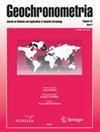青藏高原东北缘柴达木盆地雅当古湖相沉积物的ir - ir年代学
IF 0.9
4区 地球科学
Q3 Earth and Planetary Sciences
引用次数: 7
摘要
柴达木盆地保存着地球上最大的雅当田,雅当田是研究古环境和风成过程的重要地貌。沙塘的形成既包括最初的湖泊沉积,也包括随后的风蚀作用。然而,由于年龄资料有限和测年方法不合适,柴达木盆地这两个过程的时间仍然存在争议。本文首先比较了两种光学测年方法,确定了适合研究区的光学测年方法,然后基于新时代研究了该地区的地貌过程。采用长石两步后红外光谱法(pIRIR)和多段高温红外光谱法(et -pIRIR)对杨塘上部湖泊沉积物进行测年,分析了沉积环境向侵蚀环境转变的时间。两种方法的比较表明,异常衰落对MET-pIRIR方法的影响非常小,可以忽略不计,MET-pIRIR250和MET-pIRIR290之间的De平台证明了这一点;而pIR50IR250信号衰落明显,由于De接近饱和,难以校正。因此,本研究中的年表基于MET-pIRIR250方法,可能提供超过200 ka的可靠年龄。201 ~ 336 ka的7次MET-pIRIR250年龄表明,大柴达木湖(> ~ 2714 m)一直维持到海洋同位素阶段(MIS) 7。约200 ka以来沉积物的缺失暗示了MIS6以来的风蚀和yardang形成。湖泊环境向风蚀环境的转变被解释为对冰期-间冰期尺度气候变化的响应。本文章由计算机程序翻译,如有差异,请以英文原文为准。
Post-IR Irsl Chronology of Paleo-Lacustrine Sediments from Yardangs in the Qaidam Basin, NE Tibetan Plateau
Abstract The Qaidam Basin preserves the largest Yardang field on Earth, and yardangs are intriguing landforms for studies of the paleo-environment and aeolian processes. Formation of yardangs involved both the initial lacustrine deposition and the subsequent wind-erosion processes. However, the timings of both processes in the Qaidam Basin are still controversial due to limited age data and unsuitable dating methodology. In this paper, we first compared two optical dating methods to determine the suitable one for the study area, then investigated the geomorphic processes based on the new ages. Two-step post-IR IRSL (pIRIR) and multi-elevated-temperature pIRIR (MET-pIRIR) methods of feldspar, were applied to date lacustrine sediments on the top parts of yardangs to decipher the transition time from depositional to an erosional environment. Comparisons of the two methods demonstrated that the influence from anomalous fading was very minimal thus negligible for MET-pIRIR method, as proved by the De plateau between MET-pIRIR250 and MET-pIRIR290; while the pIR50IR250 signals suffered from fading obviously, which was difficult to be corrected due to the high De close to saturation. Consequently, the chronology in this study was based on the MET-pIRIR250 method, potentially offering reliable ages of over 200 ka. Seven MET-pIRIR250 ages of 201–336 ka suggested that a mega-Qaidam Lake (>2714 m a.s.l. on Google Earth) maintained until Marine Isotopic Stage (MIS) 7. The absence of sediments since ca. 200 ka implied wind-erosion and yardang formation since MIS6. This transition from lacustrine to a wind-erosion environment was interpreted as a response to the glacial-interglacial scale climatic changes.
求助全文
通过发布文献求助,成功后即可免费获取论文全文。
去求助
来源期刊

Geochronometria
地学-地球科学综合
CiteScore
2.20
自引率
0.00%
发文量
1
审稿时长
>12 weeks
期刊介绍:
Geochronometria is aimed at integrating scientists developing different methods of absolute chronology and using them in different fields of earth and other natural sciences and archaeology. The methods in use are e.g. radiocarbon, stable isotopes, isotopes of natural decay series, optically stimulated luminescence, thermoluminescence, EPR/ESR, dendrochronology, varve chronology. The journal publishes papers that are devoted to developing the dating methods as well as studies concentrating on their applications in geology, palaeoclimatology, palaeobiology, palaeohydrology, geocgraphy and archaeology etc.
 求助内容:
求助内容: 应助结果提醒方式:
应助结果提醒方式:


